This is Part 2 of a 3-part series on Making Time for Your Art. Read Part 1, Part 2, and Part 3. This series was also made into a Skillshare class which you can watch here!
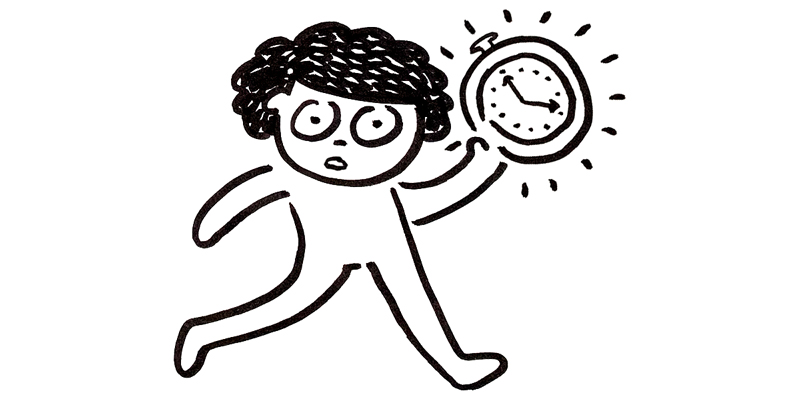
Last week I shared the first of this three-part series on not having enough time for our art. To recap where we’re going, if you find yourself often saying you “don’t have enough time to draw” you are dealing with either:
- Surface-Level Techniques: You are ready to implement tactical techniques to use your time efficiently to make more art.
- Deep-Down Issues: You are not ready for those techniques, because you have underlying, deeper issues that need to be addressed before those techniques can work for you.
Now in Part 2, I’m covering the Surface-Level Techniques. Next week we’ll dive into the Deep-Down Issues.
So where are you? You’ll know you’re in the Deep Down Issues category if you’ve tried these tactical techniques below and none of them have worked for you. Most people have a mix of both surface-level and deep-down issues. Don’t worry, we’ll cover it all and start drawing consistently again!

Time vs. Self
Before we jump straight into time management techniques, I want to make a quick distinction. The term “time management” is a bit of a misnomer.
What we’re really trying to do is manage ourselves—we’re talking about self-management.
We can’t control time, but we can alter the way we move through it. Trippy, eh?
Easing our time management issues isn’t about willpower or discipline or implementing that magical step-by-step guide on time blocking from a business guru. It’s about managing our priorities, responsibilities, and energy levels.
So with that in mind, let’s jump into six of the most common issues and actionable steps we can take to tackle them head-on!
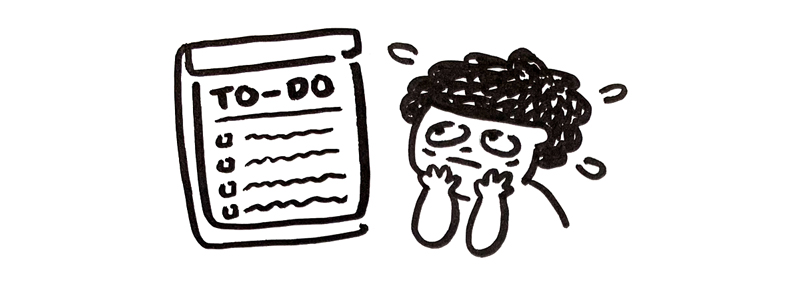
Issue 1: I’m too busy.
I know, I know. We’re all busy. Our to-do lists are overflowing and our responsibilities keep piling up. We tell ourselves, “I’ll have time for my art after I do this, this, and this.” But as soon as we do those things, more things come up! There’s just never time to sit down and draw. How can we get past this?
Consciously prioritize your time.
We make choices in how we spend our time every day. Sometimes we prioritize family, sometimes work, sometimes art, and sometimes vegging out. None of these priorities are wrong, but we have to be conscious of how we’re spending our time and what we’re choosing to prioritize if we want to make changes.
If we want to draw more, we have to prioritize it more, and that usually means prioritizing something else a little less. The first step is to be more aware of where our time goes.
Actionable Step: Write down what you believe your top 5 priorities are right now. Where does drawing or art making fall on that list? How often do you do tasks for priorities below drawing?
Ask for help.
If you constantly feel busy, you’re most likely doing too much. We live in a culture that prizes busyness, but it’s a really ineffective and unhealthy way to live. Always being busy keeps us in a reactive state of urgency instead of proactively making time for what we truly value. There’s no shame in asking for help when you’ve taken on too much.
Actionable Step: Sit your spouse or family down and tell them you’re trying to work on prioritizing creativity more in your life. You’d like to have some time to yourself when you can sit down and draw for a bit without interruptions. Ask your spouse if you could trade off certain responsibilities to carve out some time for you to draw. Tell your family your creative time is important to you and ask for their support.
Actionable Step: If work is the bigger issue for you, try to occasionally delegate things to others at work that you don’t have to do so you can leave work a little earlier. I’ve had to do this with my current book work, delegating certain tasks to Declan that don’t have to be done by me, and it’s been hard to let go, but a lifesaver for my time and energy.
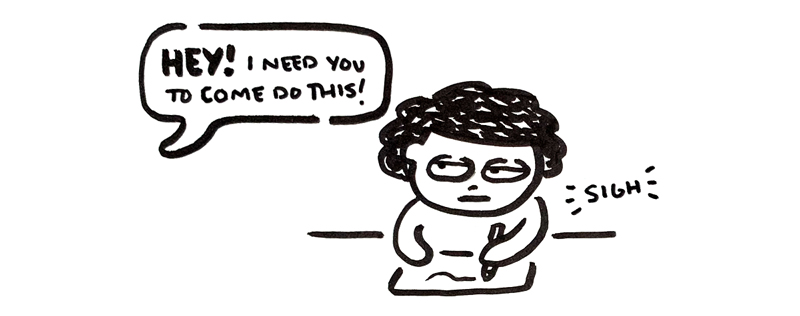
Issue 2: I get pulled into other responsibilities.
Busyness often happens because we allow other people to control our schedules and how our time is spent. If we don’t declare and defend our time, other people’s priorities will take over our own. We typically allow this to happen because of guilt and feelings of “should’s”.
Defend your time and say no.
We can focus on our responsibilities to others more than our responsibilities to ourselves, letting our wants and needs slip away. We think this is the way to be the best person/mother/father/whatever, but in the end it just makes us bitter and exhausted. We have to allow ourselves to set and defend our own needs and wants.
Sometimes that will mean saying no to things—happy hour with friends, baking yet another 3 dozen cupcakes for the school field trip, or taking on another huge project at work. It’s hard to say no, but it’s the only way to lessen the busyness and make more space for all the things we value—especially ourselves. Invitations, requests, and distractions are everywhere, and we have to turn some down to have time for art.
Once you’re clear on your priorities and goals (see Issue 3 below), it’s easier to stay on track and say no to things that don’t align with your values. Without consideration we often say yes to everything based on the assumption that other’s really need something, but that may not always be the case.
Actionable Step: Write down 1 task this week that you could say no to. Notice how easy/hard it is for you to say no. When the task or event comes up, try to use that time for drawing. Notice if you have any feelings of guilt for prioritizing yourself, and try to replace those thoughts with reminders that you are nourishing yourself, which is healthy and necessary!
Simplify other tasks and responsibilities.
I used to spend hours—hoooooours—grocery shopping and cooking each week. It just kept growing and growing until it was out of control. I enjoy cooking, but the amount of time I was spending on it was unnecessary and ultimately led by feelings of “should’s” instead of actual values and goals.
I’ve since learned to streamline cooking and grocery shopping so that I can still participate in and enjoy these activities, but not spend so much time doing it. I mean, it’s fun to spend a few hours making the best-taco-ever, but do I need to do that every night? This allows me to have extra time in my day to do other, more important things, like drawing!
Actionable Step: Think back to yesterday and write down the 5 major activities you did that day. How much time did you spend on each task? Which tasks were things you prioritized yourself, and which were motivated by “should’s”? Which tasks took perhaps an overuse of time? Which tasks could be simplified to make time for others? Try doing this step for a few days to get a better awareness of where your time goes.

Issue 3: I can’t stay motivated.
Sometimes just seeing drawing at the top of a priority list isn’t enough to maintain the motivation to do it consistently. It’s hard to stay on track with defending our time and priorities without really knowing why we’re doing what we’re doing!
Define your intentions.
Motivation can come from clarifying and reminding yourself of why we were interested in drawing in the first place. Once we have a list of those reasons, we can come back to it in moments of doubt.
If we forget why we got into drawing in the first place (or why we want to get back to it), it can be hard to stay committed. I’ve written previously in these essays about Why I Draw.
Actionable Step: Take a moment to write out why drawing is important to you. Does it improve your mental health? Is it a creative outlet? Do you want to improve your artistic skills? Do you have a big dream project you want to work towards? What do I want to achieve? What does drawing do for you?
Define your goals.
Setting specific, achievable goals can help keep you motivated and on track with your intentions. This could be part of an art project you’re working on (ie. I want to make my children’s book this year), or it could be an overarching, continuous goal (ie. I want to draw daily in my sketchbook). Or maybe your goal is to enroll and complete a course on a subject that appeals to you.
Actionable Step: Write out one SMART goal you’d like to achieve. Craft your goal with the criteria below and then post the it somewhere where you’ll see it often.
- Specific: What exactly do you want to achieve? This should be clearly defined.
- Measurable: How will you know when you’ve achieved it? You need to be able to see your progress.
- Achievable: How can this goal be achieved? You need to know the specific steps you’ll take to achieve the goal.
- Relevant: Why is this goal important to you? Make sure it align with your values.
- Time-Bound: When do you want to achieve this goal? Set a realistic target to keep you on track without setting yourself up for failure.
Take a break.
If you’ve been charging ahead on all four-cylinders for too long and feel completely unmotivated to draw often, you may be burned out! It’s normal to not feel like drawing some days and take breaks, but if this is happening regularly, something else might be wrong. Willpower and discipline can only get us so far, you may need a break. See Issue 6 below.
Actionable Step: Allow yourself to take a break from drawing (or thinking you “should” draw) one day this week. Relieve yourself of the pressure and let your creative batteries recharge. Notice if you have any feelings of guilt or shame for not drawing, and try to remind yourself that your brain and hands need rest to stay strong.

Issue 4: I can’t stick to a routine.
If we want to draw more, it can be helpful to have a creative routine to help us stay consistent. People are always trying to claim they’ve discovered the “best” or “most successful” routine, but really they’re just telling you what works for them. Everyone’s ideal routine will be different. Don’t be pressured to follow someone else’s recommendations.
Figure out when you draw best.
Different artists prefer to work in different conditions. Some people are early birds and some people are night owls. I like to draw in the late afternoon/early evening, when I feel most relaxed and have gotten a lot of stuff done. During that time, I feel I can really let go and just draw.
Life is unpredictable, and you of course won’t always be able to draw at your ideal time. But if you know what times you’re most creative, you can try to squeeze drawing in during those times as often as possible.
Actionable Step: Experiment drawing at different times on different days. Notice when it seems easier or more difficult to get into a creative mindset. Notice and write down what time it is if you get random bursts of inspiration throughout the day. Once you find what general time of day works for you, try committing to drawing during that time for a while.
Figure out how you draw best.
Do you like to be alone when you draw? Or do you like to draw in a coffee shop surrounded by strangers? Or do you like to draw next to your spouse on the couch?
Do you like to draw while listening to music? What kind? Are there certain songs that inspire your creativity? Or do you like to listen to podcasts or watch Netflix while you draw? Or do you like to draw best in silence?
What about where you draw? Do you draw best outside on your porch in the sun? Or in a comfy chair inside? Or at a desk surrounded by all your tools?
Actionable Step: Experiment with different conditions for drawing. Draw one day one way and another day another way and notice how you feel differently. Which ways of drawing put you in the creative zone? Pay attention, and find what works best for you. Once you know how you work best, you can use that to your advantage!
Create a flexible drawing routine that fits into your life.
Try not to let your routine stress you out and make drawing intimidating. The routine should help you be less anxious, not more pressured to draw. Crafting a complicated routine that you’ll never be able to keep up with is just setting yourself up for failure and disappointment. Flexibility is key!
Think about what kind of drawing routine would fit best into your schedule right now. Maybe it’s drawing 10 minutes a day. Maybe it’s drawing for 1 hour weekly. How much time do you have and what works for you?
Actionable Step: Make a routine that fits into your current schedule, not your dream schedule. You could set up a routine to squeeze in 10 minutes of drawing each day on your lunch break at work. Or make a routine to pop out a doodle while waiting in the car to pick up your kids from school. Or make a Saturday morning art session routine before everyone else wakes up. Try one out for a week and see how it works for you. Remember: be flexible and aim for consistency, not perfection!
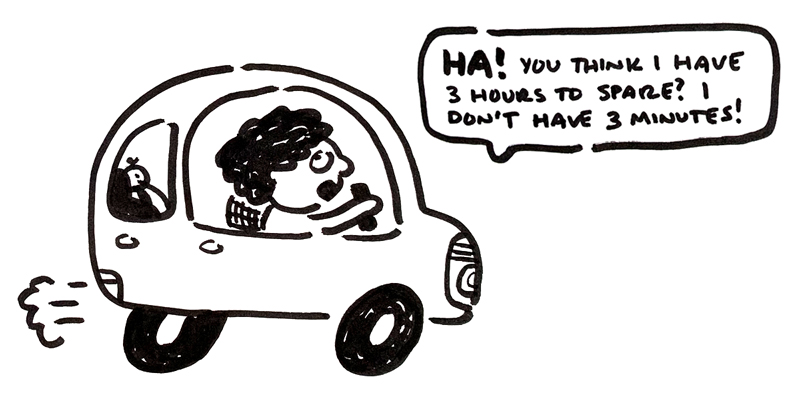
Issue 5: I don’t have big chunks of time to draw.
It’s common to have the mindset that we need to draw for hours for it to be worth our time. This is a big misconception that I’ll be talking about more in Part 3, but there are also some tactical strategies we can use to combat this belief.
Draw for short periods.
Drawing can fit into any schedule, no matter how much time you have. You don’t have a whole afternoon! Just 10 minutes each day will bring you the benefits of drawing consistently. Even 2 minutes is better than none! Little bits of work add up over time, and it can be less intimidating to get back into drawing if you plan for short drawing times.
Actionable Step: Try drawing today for just 10 minutes. If 10 minutes isn’t doable, try 5! Notice if you had any thoughts about it not being worth your time or feelings of it not being “enough”. Remind yourself that drawing is drawing no matter how long it lasts, and give yourself credit for drawing today!
Add drawing to existing tasks.
Some days we don’t have the time or energy to sit down for an art session, no matter how short it could be. In these cases, it can help to have ways to unleash our creativity in our normal daily routines. Not every drawing has to be a polished masterpiece, and we can be on the lookout for small opportunities to inject art making into our lives.
Actionable Step: Try adding drawing to a normal daily task once this week. You could draw a little cartoon on a Post-It inside your kid’s lunchbox, you could doodle on your notepad during a meeting at work, or you could draw on the bus commute to work—all these are solid ways to fit drawing into your life. What other tasks could you add?
Always have a sketchbook on you.
If you’re trying to squeeze drawing into little spurts of your day, you’ll need to always have something on you to draw with. You never know when a few extra minutes will pop up, and if you’re prepared ahead of time, it will be easier to take advantage of those pockets of free time. Stephen King credits his ability to read 80+ books a year to always having a paperback book tucked in his back pocket and car seat. He’s always prepared for those spare moments, and willing to start and stop in short bursts.
Actionable Step: Buy a couple small sketchbooks and pens and stash them in different places like your purse, car, or jacket pocket. When a free moment pops up, whip them out!

Issue 6: I’m too tired to draw.
Many people save their drawing for the end of the day, but by the time they’re done with work, dinner, homework, and everything else, they may have the time to draw, but definitely not the energy to draw. This may seem to be a time management issue, but it’s actually an energy management issue.
Practice self-care.
I’m willing to bet if you feel you don’t have time for drawing, you also feel you don’t have time for other things in your life. This problem may have less to do with your art and more to do with your overall life. Are you taking care of yourself, not just creatively, but as a whole person?
Keeping healthy habits overall will help make it easier to prioritize our art and draw consistently. Things like keeping regular sleep patterns, eating enough, staying hydrated, moving our bodies seem simple but are easy to let slip away when we’re busy. How can we expect to be able to make more art with not enough energy? Taking care of ourselves and staying healthy is extremely important.
Actionable Step: Reflect on how often you feel exhausted at the end of the day. Are you overworking yourself and running out of energy frequently? Commit to doing one act of self-care this week to nourish yourself. Sleep in an extra hour, take a nap, take a bath, eat a snack, or go for a walk. Try to stay aware of your energy levels and how to replenish them.

Making time for drawing is difficult and complex. It requires commitment and discipline, but as you can see, there are plenty of other important layers to it. Hopefully, some of these actionable steps will help you begin to draw more, little bit by little bit.
And a little bit is all you need! The more you draw, the more it builds on itself. The drawings compound, and you’ll notice with each line and each day that it becomes easier and more enjoyable to draw.
If, on the other hand, you’ve tried some of these strategies, and they’re not working for you, you may have other deeper issues to address first. And that’s where we’re going next week with the final Part 3 of this series.
This is Part 2 of a 3-part series on Making Time for Your Art. Read Part 1, Part 2, and Part 3.
Ready to make more time for your art?
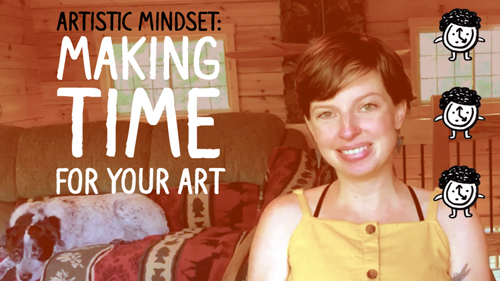
This essay inspired my Skillshare class, Artistic Mindset: Making Time for Your Art. Join us and learn how to prioritize drawing and start drawing consistently!

